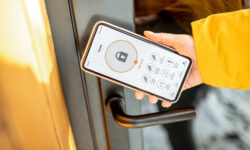Control4 Will Support Google Home, Google Assistant for IoT Voice Control Via IFTTT
Developer Chowmain updates IFTTT driver for Control4 home automation, adding support for Google Home IoT hub and Google Assistant voice control. CEO compares Amazon Alexa and Google Assistant integration platforms.

Developer Chowmain already offers IFTTT support for Control4 home automation, including Amazon Alexa (Echo) voice control. Now the New Zealand company has a driver for the Google Home IoT hub and Google Assistant speech-recognition platform.
Next week, home automation systems from Control4 (Nasdaq: CTRL) will work with the recently-launched Google Assistant speech-recognition engine for controlling the home’s audio, video and smart-home devices with simple voice commands. The voice service will work right away with Google’s new Pixel mobile phones, and in November with the new Google Home IoT hub. Integration is accomplished through the IoT engine IFTTT, thanks to a driver created by New Zealand developer Chowmain.
Earlier this year Chowmain, which specializes in Control4 integration, introduced IFTTT-based support for Amazon Alexa (Echo).
On Monday, Oct. 31, Chowmain will update the Control4 IFTTT driver to include Google Home and Google Assistant, so users can tell their thermostats to go to a specific setpoint, dim the lights to a specific level, select a channel on the living-room TV, open motorized shades a little or a lot, launch a VACATION scene, or even broadcast text-to-speech announcements throughout their home via Control4’s multiroom audio system – in a way that currently cannot be achieved with Alexa.
As always, Chowmain’s IFTTT implementation allows Control4 systems to operate other IFTTT-supported devices and services … and vice versa. For example, Control4 could control a Lifx bulb; a Belkin Wemo sensor could activate a Control4 scene. Now, these actions can be triggered by voice using either Amazon Alexa or Google Assistant (see below for numerous other examples).
Although Google doesn’t release its voice-recognition API until December, integration is possible today with IFTTT, which already has a Google Assistant “channel.”
We asked Chowmain owner Alan Chow about the development process and the differences between Google Assistant and Amazon Alexa.
What does Google have planned for integrating with Google Assistant and Google Home?
Google Assistant will open up its API in December to allow third-party manufacturers to allow their products to interact with Google Home in three different ways, using “Actions” in much the same way that Alexa uses “Skills.”
- Direct Actions – Direct Actions are just like they sound – triggering specific actions with simple requests such as, “Turn on lights in the kitchen” or “Play Dexter from Netflix.”
- Conversation Actions – Conversation Actions entail back-and-forth interactions to fulfill commands, for example: “Turn on lights.” > “Which lights?” > “In the kitchen.”
- Embedded Google Assistant – Allows manufacturers to build the Google Assistant right into a range of devices – from Raspberry Pi to mass-market consumer products.
Their IFTTT integration is what makes their product spectacular and is how we have integrated Google Home into Control4 before the product has even launched.
Google has pretty much implemented their Direct Actions into IFTTT – more “natively” than Alexa – to allow you to build trigger phrases that react on pretty much any phrase including phrases with number or text variables in them.
For example we can say, “OK Google, turn the house off,” which is a static phrase that can fire an event in Control4 which is programmed to perform an ALL OFF scene. Or we can do more advanced stuff like “OK Google, set the living room thermostat to 70 degrees,” which will fire an event in Control4 which will pass through LIVING ROOM THERMOSTAT and 70 as the variables.
Now that you’ve experienced both Amazon Alexa and Google Home/Assistant integration, is one easier than the other?
Alexa currently requires a manufacturer to create a cloud-based service to implement native Alexa Skills. Developers then need to go through a certification process with Amazon to get Skills passed. It takes a massive amount of effort from the manufacturer to get it to work.
Even when going down the IFTTT route with Amazon Alexa, it does not have the power that Google Assistant has. IFTTT for Alexa only allows users to say a static phrase that is linked to a specific action within the home automation system – Control4 in our case. So, for example, you can say, “Alexa trigger house off” to activate Control4’s pre-programmed HOUSE OFF scene, but you can’t use the command, “Close the living room shades 50 percent.”
Do you think one platform is better than the other for voice control?
This is a pretty big question. Both platforms offer similar functionality. Amazon does have a head start, as they released Echo back in 2014 and have captured a significant amount of attention from the market.
If we concentrate on the smart home, then Amazon is winning the race today, since out of box it will work with IoT devices like Nest, Ecobee, SmartThings, Wink, Insteon, Belkin Wemo, Philips Hue, Lifx, Big Ass Fans and the major automation systems like Control4 and Elan.
I do, however, think that over the coming months Google will catch up extremely quickly.
Google will be launching with a few IoT devices (Nest, SmartThings and Philips Hue) and they seem to be really opening up their platform for anyone to use.
They were smart enough to make their IFTTT channel extremely flexible and thus making it easy for anyone to create interesting combinations of phrases for control.
By giving you the ability to enter in alternative ways of saying the same phrase it minimizes programming time.
Overall I think that having competition in this space is good and it will really drive innovation from both Amazon and Google which in the end will benefit the home automation market.
Are other home automation manufacturers starting to integrate with Google Home and Assistant?
I can’t speak for what the manufacturers are doing right now – I honestly don’t know – but I can say that they will be silly not to. Integration with Google Assistant not only offers you a Wi-Fi speaker in the home but offers you control via the new Google Pixel phones, as well as Google’s new Allo instant-messaging app.
READ: ADT Partners With IFTTT for DIY Home Automation Channel
Examples of Control4 Actions via IFTTT
OUTBOUND EXAMPLES (CONTROL4 > IFTTT)
- Control4 can send SMS’s via your Android phone (IF app must be downloaded to the phone).
- Control4 can call your phone number and say a message (for security alarms, smoke alarms and other emergencies).
- Control4 can save data about the events in your home in google docs or dropbox.
- Control4 can save data about the events in your home to IFTTT’s daily or weekly email digest.
- Control4 can send emails out without 4sight or 3rd party driver.
- Control4 can send push notifications out without 4sight or 3rd party driver (using pushalot, pushbullet or pushover).
- Control4 can send Skype messages.
- Control4 can send notifications to your Android wear device (requires IF app installed).
- Control4 can send your BMW (Connected Drive Compatible) a message on your car’s front screen display (120 characters limited).
- Control4 can find lost items (needs tags) or phones (call your phone).
- Control4 can send your Tesla (EVE enabled) a message (with subject, message and message type fields) on your car’s das
hboard. - Control4 can turn on or off your GE Smart Appliance and more.
- Control4 can tell your Android phone to turn on/off Bluetooth or wifi.
- When batteries are low on your Control4 sensors add a reminder to your IOS reminders app.
INBOUND EXAMPLES (IFTTT > CONTROL4)
- Amazon Alexa (Amazon Echo, Tap, etc) can send commands to Control4 via voice recognition to do things like turn lights on, play music, house off and more.
- Assissant.ai can send commands to Control4 via voice recognition.
- Control4 can read out stock prices or notify you when they raise or lower (requires Chowmain Advanced Announcements Driver).
- Control4 can pause your music and videos when you answer your phone (android only).
- Control4 can detect if a specific person has entered or left a room/zone using beacons.
- iOS Location and Android Location (via the IF app) can tell Control4 when you are approaching or leaving home.
- Send a warning to Control4 when something has been picked up or moved (needs wireless tag).
- Your BMW (Connected Drive Compatible) can tell Control4 when it is entering or exiting an area.
- Your EVE enabled Tesla car can tell Control4 when it has arrived home, is leaving home or on the way home.
- Your Automatic, Zubie or Dash enabled car can tell Conrol4 when you have turned the car on or off within a certain area.
- Your GE, LG and Samsung Smart appliances can tell Control4 when it has been turned on, off, if for example an oven timer is done, if there is a leak in the dishwasher, if the filter needs cleaning, if the dryer cycle has finished, if the fridge door has been left open for too long.
- Your Nest Protect smoke alarm can send Control4 smoke emergency, warning and carbon monoxide emergencies.
- Your Netatmo Welcome can tell Control4 when a specific person, known person or even an unknown person has been seen or arrives home (facial recognition).
- Your Roost Smart Battery can tell Control4 (via the announcement agent) when its battery is low (Great for smoke alarms).
- Control Control4 via SMS or phone call to IFTTT.
- Have Control4 read out your meetings (including subject, body & location) on outlook 365 calendar or Google calendar 15 minutes before the meeting (requires Chowmain Advanced Announcements driver).
- If the temperature (via weather forecast/conditions) changes in your area tell Control4 to do something.
- Your Android phone can tell Control4 when it has connected or disconnected to/from a specific Wifi network.
- Change the colours of your RGB LED’s to your teams colour using the ESPN channel when the game starts.
If you enjoyed this article and want to receive more valuable industry content like this, click here to sign up for our FREE digital newsletters!

Security Is Our Business, Too
For professionals who recommend, buy and install all types of electronic security equipment, a free subscription to Commercial Integrator + Security Sales & Integration is like having a consultant on call. You’ll find an ideal balance of technology and business coverage, with installation tips and techniques for products and updates on how to add to your bottom line.
A FREE subscription to the top resource for security and integration industry will prove to be invaluable.








